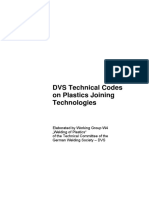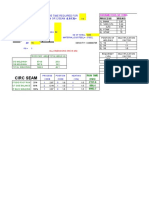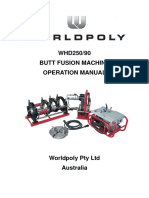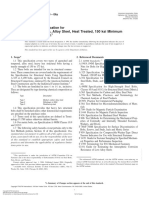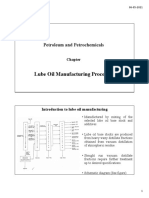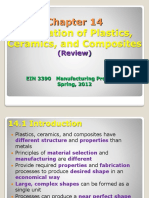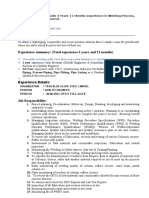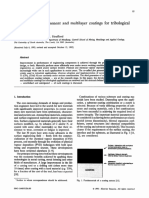R&D Intake Manifolds: Pressure
R&D Intake Manifolds: Pressure
Uploaded by
Васил СавовскиCopyright:
Available Formats
R&D Intake Manifolds: Pressure
R&D Intake Manifolds: Pressure
Uploaded by
Васил СавовскиOriginal Title
Copyright
Available Formats
Share this document
Did you find this document useful?
Is this content inappropriate?
Copyright:
Available Formats
R&D Intake Manifolds: Pressure
R&D Intake Manifolds: Pressure
Uploaded by
Васил СавовскиCopyright:
Available Formats
Page 3 to DVS 2207-11
pressure possible, with a linear rise. The times necessary for this purpose
are shown in Table 2, Column 5. The joining pressure is
joining pressure 0.10 ± 0.01 N/mm².
alignment pressure
R&D INTAKE MANIFOLDS
A mechanical load on the joint is permissible, at the earliest, after
the end of the cooling process. For this purpose, the full joining
heating-up pressure must be maintained during the cooling time at the
pressure ambient temperature (see Table 2, Column 5).
time Subject to the following prerequisites, it is permitted to shorten
changeover time
heating-up the cooling time by as much as 50%, i. e. joining pressure relief
time cooling time and removal of the welded part from the welding machine:
alignment joining pressure build-up time – the joint is manufactured in workshop conditions,
time
total joining time
– the removal from the welding machine and the temporary
total welding time storage cause only a slight load on the joint and
– the joining parts have wall thicknesses ≥ 15 mm.
Figure 2. Process steps in heated tool butt welding. Further processing with a full mechanical load on the joint may
only take place after complete cooling according to Table 2,
Alignment Column 5.
In this respect, the joining faces to be welded are pressed on to
A uniform double bead must exist after the joining. The bead
the heated tool until the entire faces are in contact with the
formation provides orientation with regard to the uniformity of the
heated tool with parallel faces. This can be recognised by the
welds with each other. Different bead formations may be caused
formation of the beads. The alignment is finished when the bead
by the various types of flow behaviour of the joined materials.
heights around the entire pipe circumference or on the entire top
The weldability may be assumed from the experience with the
side of the plate have reached the values specified in Table 2,
commercially available semi-finished PP products in the specified
Column 2. The bead heights are regarded as an indicator that the
MFR range, even if this may lead to asymmetric welding beads.
whole area of the joining faces is in contact with the heated tool.
K must always be > 0 (see Figure 3).
The alignment pressure of 0.10 N/mm² is effective throughout the
alignment operation.
Heating-up
For the heating-up, the faces must be in contact with the heated
tool at a low pressure. To this end, the pressure is reduced to
nearly zero (≤ 0.01 N/mm²). During the heating-up, the heat
penetrates into the faces to be welded and heats these up to the
welding temperature. The heating-up times are shown in Table 2,
Column 3.
Changeover
After the heating-up, the joining faces must be detached from the
heated tool which must be taken out without damaging or soiling
the heated joining faces. The joining faces must then be moved
together quickly until they almost touch. The changeover time
should be kept as short as possible (see Table 2, Column 4)
since the plastified faces would otherwise cool down. This would
exert a detrimental influence on the weld quality. Figure 3. Bead formation in the case of heated tool butt welding
(principle using the example of a pipe).
Joining
The faces to be welded should come into contact at a speed of For a short version of the processing instructions, see the
nearly zero. The required joining pressure is applied, if at all appendix.
Table 2. Guide values for the heated tool butt welding of pipes, fittings and panels made of PP at an outdoor temperature of approx. 20°C with
moderate air movement (intermediate values must be interpolated).
1 2 3 4 5
Alignment Heating-up Changeover Joining
Heated tool temperature 210 ± 10°C
Nominal wall Changeover Joining Cooling time under
Bead height at the heated tool time pressure joining pressure
thickness s
at the end of the alignment time (Heating-up (maximum build-up (minimum values)
(minimum values) p = ≤ 0.01 N/mm2) time) time p = 0.10 ± 0.01 N/mm²
(alignment p = 0.10 N/mm2)
mm mm s s s min
Up to 4.5 0.5 up to 135 5 6 6
4.5 ... 7 0.5 135 ... 175 5 ... 6 6 .. 7 6 ...12
7 ... 12 1.0 175 ... 245 6 ... 7 7 .. 11 12 ... 20
12 ... 19 1.0 245 ... 330 7 ... 9 11 ... 17 20 ... 30
19 ... 26 1.5 330 ... 400 9 ... 11 17 ... 22 30 ... 40
26 ... 37 2.0 400 ... 485 11 ... 14 22 ... 32 40 ... 55
37 ... 50 2.5 485 ... 560 14 ... 17 32 ... 43 55 ... 70
407
You might also like
- Kumiko Jigs Japanese Woodworking PDFDocument9 pagesKumiko Jigs Japanese Woodworking PDFJaime Montiel75% (4)
- Holiday Test ReportDocument17 pagesHoliday Test ReportZaid Raslan AyoubNo ratings yet
- Astm A335 P9 Alloy Steel PipeDocument3 pagesAstm A335 P9 Alloy Steel PipeHamid MansouriNo ratings yet
- Certificado Calidad-Viga HDocument1 pageCertificado Calidad-Viga HALE100% (1)
- ASTM A325 SpecificationDocument2 pagesASTM A325 SpecificationRay CoelloNo ratings yet
- Fusion 3 LeisterDocument1 pageFusion 3 LeisterJames WrightNo ratings yet
- R&D Intake Manifolds: Welding of ThermoplasticsDocument1 pageR&D Intake Manifolds: Welding of ThermoplasticsВасил СавовскиNo ratings yet
- 4S-10.01 Simons FRP Structures PDFDocument27 pages4S-10.01 Simons FRP Structures PDFjdiaz87No ratings yet
- DVS 2207-12 Soldadura de Termoplasticos - Soldadura de Tubos y Accesorios de PVC-UDocument7 pagesDVS 2207-12 Soldadura de Termoplasticos - Soldadura de Tubos y Accesorios de PVC-UEugenioNo ratings yet
- Widos MaxiplastDocument1 pageWidos Maxiplastsealion72No ratings yet
- Astm-53-A-53m-07Document22 pagesAstm-53-A-53m-07Allen EspeletaNo ratings yet
- PCR PCRH Full lit-SP PDFDocument18 pagesPCR PCRH Full lit-SP PDFjuanfco1965100% (1)
- Mcelroy Hdpe Standars To Fusion Academy - May 2024Document80 pagesMcelroy Hdpe Standars To Fusion Academy - May 2024Rene CisternasNo ratings yet
- Soldaduras Varios PDFDocument54 pagesSoldaduras Varios PDFCristhian AndresNo ratings yet
- Rociador ESFR K16.8 PDFDocument4 pagesRociador ESFR K16.8 PDFLEONARDONo ratings yet
- Mock-Up of HDPE Weld and Testing PDFDocument1 pageMock-Up of HDPE Weld and Testing PDFPramod PeethambaranNo ratings yet
- ENG2068 SampleofcontentsDocument10 pagesENG2068 SampleofcontentsKlich77No ratings yet
- AWS G1.1-G1.1M-2006 Guide For The Ultrasonic Assembly of ThermoplasticsDocument96 pagesAWS G1.1-G1.1M-2006 Guide For The Ultrasonic Assembly of ThermoplasticsJeff MNo ratings yet
- Vdocuments - MX - PT 355 Manual PDFDocument32 pagesVdocuments - MX - PT 355 Manual PDFMamadou Mb MacinaNo ratings yet
- Iagi Ingles PDFDocument30 pagesIagi Ingles PDFMatzelo ResetNo ratings yet
- Astm-F 2164Document5 pagesAstm-F 2164damithNo ratings yet
- Torque Value For HdpeDocument1 pageTorque Value For Hdpenatee8632No ratings yet
- AGRU-Technical-Butt WeldingDocument4 pagesAGRU-Technical-Butt Weldingrenne_mujicaNo ratings yet
- Flexitallic SpiralDocument52 pagesFlexitallic Spiralgochi bestNo ratings yet
- DVS 2225-2Document7 pagesDVS 2225-2Roberto Gomez R.100% (1)
- Data Sheet: Elcometer 124 Thickness GaugeDocument3 pagesData Sheet: Elcometer 124 Thickness GaugeMohamed NouzerNo ratings yet
- Vetonit Doc Technical Map en 2715Document2 pagesVetonit Doc Technical Map en 2715Thahir HussainNo ratings yet
- Visual Inspection Acceptance Criteria (See: ProhibitionDocument1 pageVisual Inspection Acceptance Criteria (See: ProhibitionSaptarshi MandalNo ratings yet
- Polyken 2036Document2 pagesPolyken 2036nrd9771No ratings yet
- Garlock 700Document1 pageGarlock 700Jairo ArroyoNo ratings yet
- Mcelroy Rolling 412 618 ManualDocument54 pagesMcelroy Rolling 412 618 Manualadiel soto vegaNo ratings yet
- Certificado Revelador Skd-S 2Document3 pagesCertificado Revelador Skd-S 2Enrique AntonioNo ratings yet
- Astm C0969 - 1 (En)Document3 pagesAstm C0969 - 1 (En)Dinesh Sai100% (2)
- Series FV: Cantilever Sump PumpsDocument4 pagesSeries FV: Cantilever Sump PumpsFranciscoNo ratings yet
- Normas DVS PDFDocument11 pagesNormas DVS PDFrodrigo diaz poblete100% (1)
- Ficha Tecnica Geomembrana PVC 1.00 MM - GeotexanDocument1 pageFicha Tecnica Geomembrana PVC 1.00 MM - GeotexanAngel Manrique LeonNo ratings yet
- Electrode E8018 DetailsDocument1 pageElectrode E8018 DetailskapsarcNo ratings yet
- ASTM-D8468-23 - Standard Practice For Data Recording Devices For Welding Devices Used To Produce Thermal Fusion Welds in Geomembrane SystemsDocument2 pagesASTM-D8468-23 - Standard Practice For Data Recording Devices For Welding Devices Used To Produce Thermal Fusion Welds in Geomembrane Systemsvinicius.cabalinNo ratings yet
- The UL Certificate of The Gate Valve-JINAN MEIDEDocument5 pagesThe UL Certificate of The Gate Valve-JINAN MEIDEIRENENo ratings yet
- Circ Seam: Run Time Time Required For L/Seam or C/Seam (LS/CS) CsDocument5 pagesCirc Seam: Run Time Time Required For L/Seam or C/Seam (LS/CS) CsMina RemonNo ratings yet
- Cab3 Cab4 Series Cabinets Product (15330)Document5 pagesCab3 Cab4 Series Cabinets Product (15330)Evita Elizabeth Ramos CuevasNo ratings yet
- Hydrostatic Test ProcedureDocument3 pagesHydrostatic Test ProceduregabrielNo ratings yet
- Manual Elcometer 280Document96 pagesManual Elcometer 280jairht29No ratings yet
- WHD250 Worldpoly Operation ManualDocument34 pagesWHD250 Worldpoly Operation ManualalejandroNo ratings yet
- GRI GM19aDocument13 pagesGRI GM19aAllen EstelaNo ratings yet
- Anexo T - API 650Document4 pagesAnexo T - API 650ChristiaanNo ratings yet
- ASTM G62 Standard Test Methods For Holiday Detection in Pipeline CoatingsDocument4 pagesASTM G62 Standard Test Methods For Holiday Detection in Pipeline Coatingshenry ayalaNo ratings yet
- Daily Work Report For Sandblasting & Painting Date: Day of Week: Weather & Atmospheric ConditionsDocument5 pagesDaily Work Report For Sandblasting & Painting Date: Day of Week: Weather & Atmospheric ConditionsJerick VillonesNo ratings yet
- TB27a ENDocument4 pagesTB27a ENandy131078No ratings yet
- Cat#703r4 HTW201Document8 pagesCat#703r4 HTW201sidparikh254No ratings yet
- Astm A 490Document6 pagesAstm A 490Pedro Diaz UzcateguiNo ratings yet
- Denso Protal 7200Document2 pagesDenso Protal 7200min_one447065No ratings yet
- 4685 POLYCOTE SW Ficha TecnicaDocument2 pages4685 POLYCOTE SW Ficha TecnicaGenesis Alejandra Mancilla CaniuNo ratings yet
- Guía de Evaluación AWS G1.10MDocument45 pagesGuía de Evaluación AWS G1.10MDaniel Jimenez100% (1)
- Hoja de Datos Vican Serie 124Document1 pageHoja de Datos Vican Serie 124jarpeasvNo ratings yet
- Dic Pps Weld StrengthDocument1 pageDic Pps Weld StrengthWoong KimNo ratings yet
- Astm F 2389 - 2017aDocument10 pagesAstm F 2389 - 2017aErika Viridiana AldaranNo ratings yet
- Butt WeldingDocument4 pagesButt WeldingNavin Ullas100% (1)
- Specification For Welding Thermalplastic HdpeDocument5 pagesSpecification For Welding Thermalplastic Hdpekhiêm phạmNo ratings yet
- HDPE Jointing Methods: Butt-Weld ProcessDocument1 pageHDPE Jointing Methods: Butt-Weld ProcessBoraNo ratings yet
- Heated Tool WeldingDocument14 pagesHeated Tool WeldingВасил СавовскиNo ratings yet
- R&D Intake Manifolds: Sleeve Welding With An Incorporated Electric Heating Element (Principle)Document1 pageR&D Intake Manifolds: Sleeve Welding With An Incorporated Electric Heating Element (Principle)Васил СавовскиNo ratings yet
- R&D Intake Manifolds: PreparationDocument1 pageR&D Intake Manifolds: PreparationВасил СавовскиNo ratings yet
- Buttweld SpecsDocument14 pagesButtweld SpecsВасил СавовскиNo ratings yet
- Heated Tool WeldingDocument14 pagesHeated Tool WeldingВасил СавовскиNo ratings yet
- Hot Gas WeldingDocument9 pagesHot Gas WeldingВасил СавовскиNo ratings yet
- Hot Plate and Hot Gas WeldingDocument14 pagesHot Plate and Hot Gas WeldingВасил СавовскиNo ratings yet
- Architectural Manual: Paintable GalvannealDocument9 pagesArchitectural Manual: Paintable Galvanneal018601No ratings yet
- 12 Machinery Ebook PDFDocument135 pages12 Machinery Ebook PDFTeuku Andy Nur IsaNo ratings yet
- Product Catalogue: Your Specialist in Flow DrillingDocument64 pagesProduct Catalogue: Your Specialist in Flow DrillingВасяNo ratings yet
- Lube Oil ManufacturingDocument7 pagesLube Oil ManufacturingLakshya SaxenaNo ratings yet
- CatalogDocument44 pagesCatalogadrianioantomaNo ratings yet
- Astm F3329 18Document2 pagesAstm F3329 18Ramin ShojaNo ratings yet
- Formica Laminate by Formica Group Technical Data: (General Pupose Grade 10 and Post-Forming Grades 12 & 20)Document4 pagesFormica Laminate by Formica Group Technical Data: (General Pupose Grade 10 and Post-Forming Grades 12 & 20)Billy Joe BreakfastNo ratings yet
- AK-47 BuildDocument105 pagesAK-47 BuildProfessor50% (2)
- Best Rotary Kiln Incinerator Manufacturers in India - BL EngineeringDocument2 pagesBest Rotary Kiln Incinerator Manufacturers in India - BL Engineeringbl engineeringNo ratings yet
- Alloy Steels: Table 4.2 Typical Mechanical Properties of Some Commercial Steels at Room TemperatureDocument2 pagesAlloy Steels: Table 4.2 Typical Mechanical Properties of Some Commercial Steels at Room TemperatureBharathi SrinivasanNo ratings yet
- Dynasolve™ 185: Cleaning Applications: Product Usage GuidelinesDocument2 pagesDynasolve™ 185: Cleaning Applications: Product Usage Guidelinesmario230991No ratings yet
- Encapsulated O-Rings MarketDocument24 pagesEncapsulated O-Rings Marketkhushboo chandaniNo ratings yet
- Cloverdale Tds 83021a eDocument4 pagesCloverdale Tds 83021a eErnesto Javier Martín RosabalNo ratings yet
- FlexibleDocument27 pagesFlexibleVashi AhamadNo ratings yet
- T 513 PG 123-128 PDFDocument6 pagesT 513 PG 123-128 PDFJossimar PerezNo ratings yet
- Fabrication of Plastics, Ceramics, and Composites: (Review)Document34 pagesFabrication of Plastics, Ceramics, and Composites: (Review)Joshua StrykrNo ratings yet
- Piping Work (P0280 P0361Document23 pagesPiping Work (P0280 P0361Cường VũNo ratings yet
- GratingDocument8 pagesGratingGhanshyam PandeyNo ratings yet
- Rilco Aerogel ProductsDocument1 pageRilco Aerogel Productsnhr71No ratings yet
- Module 1Document10 pagesModule 1Meenakshi SinghNo ratings yet
- 2) Everyday Paint Indent & Status DetailsDocument61 pages2) Everyday Paint Indent & Status DetailsStructures ProductionNo ratings yet
- N236 - SpecDocument2 pagesN236 - SpecSrikanth KrishnamurthyNo ratings yet
- Drying and Curing Time: Application Guide Pilot IIDocument1 pageDrying and Curing Time: Application Guide Pilot IITamerTamerNo ratings yet
- Selection of Welding Process WRT MaterialDocument1 pageSelection of Welding Process WRT MaterialMurugananthamParamasivamNo ratings yet
- Editable Welding Resume TemplateDocument6 pagesEditable Welding Resume TemplatejeyesbelmenNo ratings yet
- Surface Chemistry and ElectroplatingDocument33 pagesSurface Chemistry and ElectroplatingAhmed ImranNo ratings yet
- Neoproof Polyurea Η en 1Document3 pagesNeoproof Polyurea Η en 1nguyen hoang AnhNo ratings yet
- Sample Test 2 TleDocument4 pagesSample Test 2 TlePia Margaret AmparoNo ratings yet
- Review of Multicomponent and Multilayer Coatings For TribologicalDocument11 pagesReview of Multicomponent and Multilayer Coatings For TribologicalFernando Spanholi TelesNo ratings yet


































